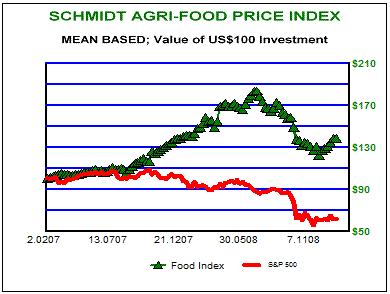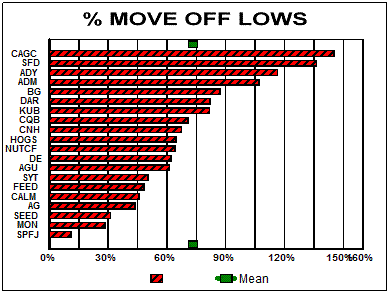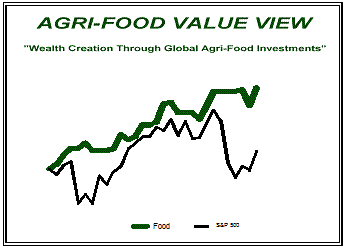Agri-Foods Bullish Outlook due to Over Optimistic USDA Crop Forecasts
Commodities / Agricultural Commodities Jan 13, 2009 - 05:27 PM GMTBy: Ned_W_Schmidt

 Remember as we have talked before, commodities is not a homogeneous asset class. It includes three asset groups, each with distinctively different dynamics and drivers. Energy group, for one, includes oil, natural gas, uranium, etc. Mineral ores, the second group, includes iron, copper, Gold, etc. Third group is Agri-Food, which includes corn, soybeans, pork, etc. That latter group is now again separating itself from the others, and moving on its own path.
Remember as we have talked before, commodities is not a homogeneous asset class. It includes three asset groups, each with distinctively different dynamics and drivers. Energy group, for one, includes oil, natural gas, uranium, etc. Mineral ores, the second group, includes iron, copper, Gold, etc. Third group is Agri-Food, which includes corn, soybeans, pork, etc. That latter group is now again separating itself from the others, and moving on its own path.
Out first graph this week, found below, is of the Schmidt Agri-Food Price Index, Mean Based, versus the S&P 500. That price index represents the price action in the major grains and meats. We note that the price action over time has been distinctly superior. Reasons for that performance exist. Demand for Agri-Foods has a structural component, largely unaffected by short-term economic activity. About 15 million people per year are joining the middle class each year in China. That will happen regardless of the change in Chinese exports in the next month. And those consumers moving up the economic ladders are going to strive to eat better, especially meats which are grain “hogs.” 
Second observation in that chart is that the downtrend brought on by the most welcome collapse of the hedge fund industry seems to be losing power. The index is attempting to walk through the down trend line drawn into the chart. That would suggest that the down trend is no longer dominant, or controlling. Trades trying to extend gains from the down trend will disappoint, for a new trend, up, is now evolving.
The latest crop forecasts from the USDA are an example of exaggerated expectations that come from extrapolating current trends indefinitely, and a wildy optimistic on production. Any sell off of prices in response to this report would be consistent with the negativism that is popular at bottoms, not tops. Most grain stochastics have high reading which suggest a period of rest is necessary. USDA report may cause it to happen. Agri-Food investors should be adding to positions during such periods, for paper corn in imagination of a USDA economist is far easier to produce than real corn.
 Rising demand for Agri-Food around the world, especially from China and India, will increasingly bump into the natural and structural ceiling on global Agri-Food production. Already the forecasts for global grain production are being lowered for the next year. Rising demand around the world is facing declining grain production in 2009. Overtime, the structural nature of a global Agri-Food shortage situation will become more obvious.
Rising demand for Agri-Food around the world, especially from China and India, will increasingly bump into the natural and structural ceiling on global Agri-Food production. Already the forecasts for global grain production are being lowered for the next year. Rising demand around the world is facing declining grain production in 2009. Overtime, the structural nature of a global Agri-Food shortage situation will become more obvious.
Much discussion still seems to focus on the financial failures of the past year. Others are deluding themselves to believe that the Sun will rise somehow differently on 20 th of January. All of that may be fun, but the money has been moving on to the investment themes for the future that have merit. The transition to new investment themes has started. Investors need to seek out the real changes in the world that will persist for the next decade, not the fantasy political game of the first 100 days which is about to start.
As shown in the second chart, above, the Agri-Food stocks have already begun to dance to the beat of the future. That chart plots the percentage change from the lows of the past year for a basket of important Agri-Food stocks. The average gain has been about 70% versus about 20% for the S&P 500. Clearly, some investors are already moving on to the future, rather than being mired in the past.
 Agri-Food investments, like Gold, may have some special friends around the world. Governments, of all kinds, are attempting to stimulate economic growth and move incomes higher. Those efforts by both political leadership and the central banks are aimed at keeping people in their homes, a doomed effort, and keeping people happily fed. The Chinese government is working on a $600 billion stimulus package. The U.S. Federal Reserve will apparently monetize any asset presented to it. Government sometimes can be an investor's friend.
Agri-Food investments, like Gold, may have some special friends around the world. Governments, of all kinds, are attempting to stimulate economic growth and move incomes higher. Those efforts by both political leadership and the central banks are aimed at keeping people in their homes, a doomed effort, and keeping people happily fed. The Chinese government is working on a $600 billion stimulus package. The U.S. Federal Reserve will apparently monetize any asset presented to it. Government sometimes can be an investor's friend.
Structural investment themes rarely develop. Agri-Food certainly looks to be one of those rare jewels. Growing global demand combined with an inability of global Agri-Food supply to expand sufficiently to satisfy that demand over the coming decade could be a strong economic combination. Investors that have not turned their mental calendars to 2009 and beyond should be considering the possibly potent forces at work in Agri-Food.
By Ned W Schmidt CFA, CEBS
AGRI-FOOD THOUGHTS is from Ned W. Schmidt,CFA,CEBS, publisher of The Agri-Food Value View , a monthly exploration of the Agri-Food grand cycle being created by China, India, and Eco-energy. To receive the most recent issue of this publication, use this link: http://home.att.net/~nwschmidt/Order_AgriValueRECENT.html
Copyright © 2009 Ned W. Schmidt - All Rights Reserved
Ned W Schmidt Archive |
© 2005-2022 http://www.MarketOracle.co.uk - The Market Oracle is a FREE Daily Financial Markets Analysis & Forecasting online publication.


